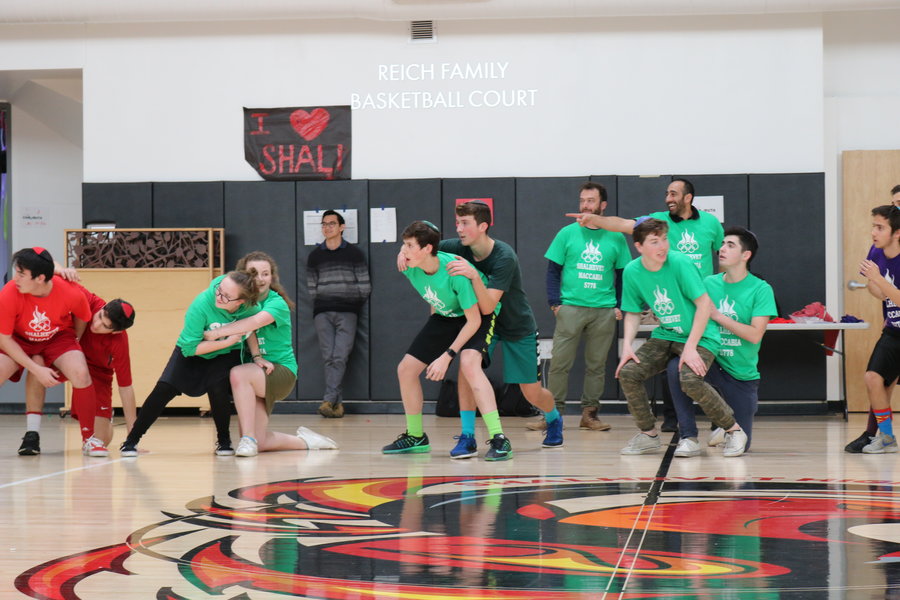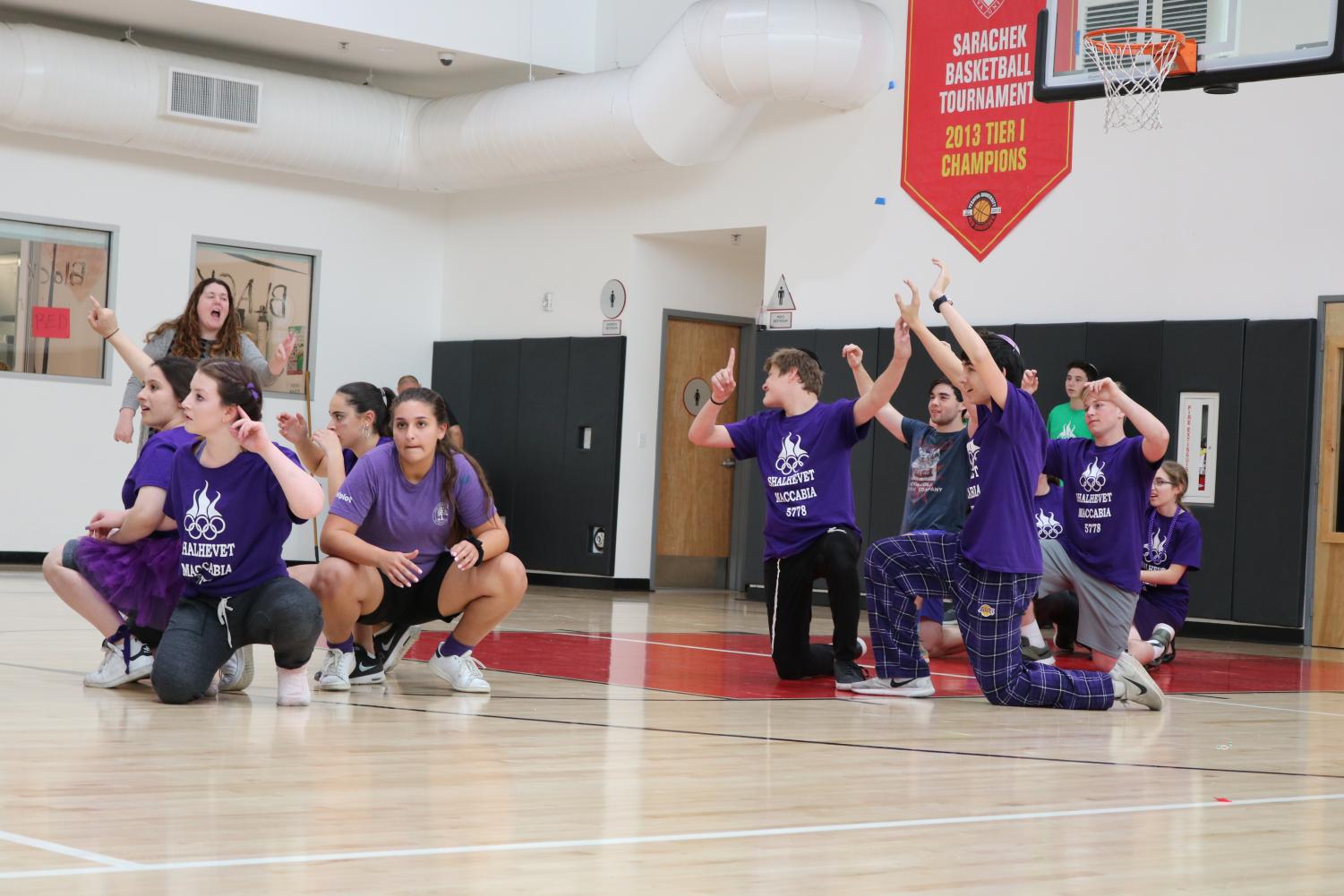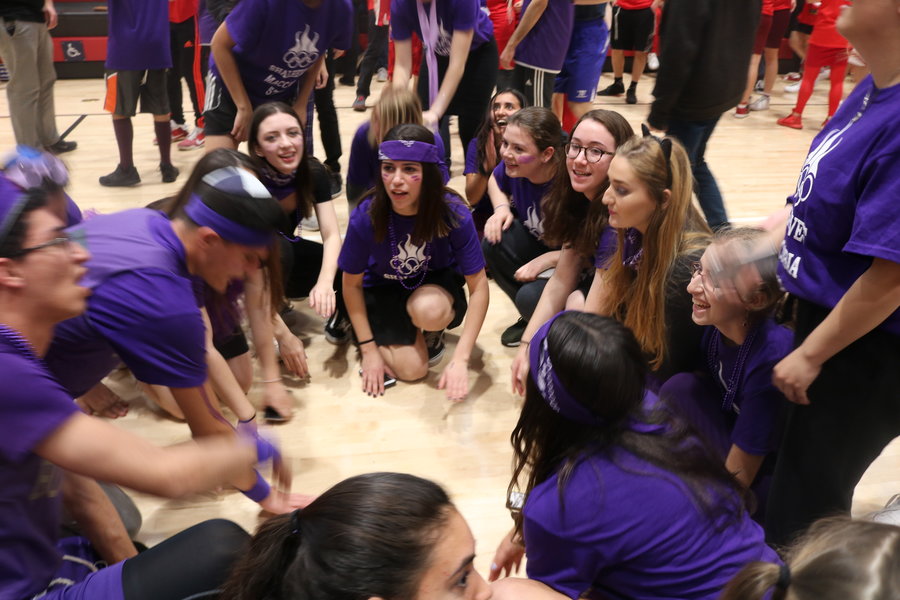COLOR WAR 2018: Intense competition, shortcuts and penalties, a hard-boiled egg genius and a senior three-peat make it memorable
April 3, 2018

Editor’s note:
These stories appeared in the Boiling Point’s Issue 4, in early March, less than two weeks after Color War ended, but we are just posting them now to our website. We delayed uploading this content as a sign of respect for the victims and survivors of the gun attack at Marjory Stoneman Douglas High School.
Color War broke out Feb. 20, just a few days after the shooting took place, and many were still processing the horrific event while playing silly competitions. We have focused our coverage on the students from MSD who have spoken to Shalhevet students and faculty on two different occasions since the shooting, along with the security review at our school, the walkout on March 14, and other updates.
Because we are committed to reporting what is happening in our community truthfully, we took a different approach in our March print edition, where a schoolwide security meeting was the lead story that ran alongside photos of the Egg Roulette competition in Color War on Page 1. Some of our readers were confused, even critical, about our decision to place the serious story with silly photos. But the reality was these two things happened almost simultaneously, and the next print paper was weeks away.
While the consequences of the Feb. 14 shooting will be never be entirely in the past, after having thoroughly covered that event, we believe it is now appropriate to post our coverage of Color War.
— Hannah Jannol, Editor-in-Chief
For many students, Color War is the highlight of the school year; for everyone it’s the most elaborate of any schoolwide actiivty. This year it was even longer than last, running from from 3:30 pm Tuesday until 8:30 pm Thursday, Feb. 20 – 22.
Teams were made up of all the students in each grade. Freshman wore black, sophomores wore green, juniors sported red and the senior class of 2018 donned purple. They wore it not only in their clothes but also on their faces with paint, in their hair with colored spray and any other way they could find to express pride for their team.
All day Wednesday and Thursday, the grades competed against each other in a myriad of competitions, vying for an overall first place title. This year’s seniors, the class of 2018, had won it last year and the year before, so everyone’s drive to win was intense.
Events ranged from the fast-paced Apache Race to quirky games like the Egg Roulette and Hungry Hungry Hippos, to less physical contests like the skit, “College Bowl,” an art competition and the team song. Four students from each grade were selected by the Student Activities Committee (SAC) to be team captains.
Numerous faculty members, led by Judaic Studies teacher Ms. Ilana Wilner, Student Activities Dean Dr. Jonathan Ravanshenas and SAC co-chairs Summer Gershon and Ariel Cohen, planned coordinated, and judged the events.
In the end, the seniors were said to have received the most points for the third year in a row. The sophomores came in second, the juniors came in third and the 9th grade came in last, officials reported.
As usual, there was some debate over who placed where and how. As in past years, point totals were not shared with students or The Boiling Point by the referees, who worried it might hurt the feelings of students who did not receive a lot of points and that they might then argue with the referees about it. So we can’t provide those details.
Still, one contest is the Boilnig Point Coverage competition, in which each team is assigned one event to cover. Some of the articles and photos in this issue were submitted for points — you can find them below, along with original editorials.
We hope you enjoy reliving this year’s Color War. And for the record, the seniors won the Coverage competition, and the freshmen came in second, according to Mrs. Keene, who judged it.
This story is a finalist for NSPA’s 2018 Digital Story of the Year in the category of Multimedia Sports Story Package.

SAFE: Members of the Red and Green teams ran to their partners’ laps as they tried to stay in the game.
COLOR WAR: Disputed call gave ‘Coke – Pepsi’ game to the seniors; juniors still have not conceded
By Molly Litvak, Staff Writer, and Lucy Fried, Torah Editor
The stakes were high as a sea of students, each grade wearing a different color, flooded into the gym for the last event of the first day of Color War.
The whole school was there, some 250 students and about 50 staff. Seniors wore purple, juniors wore red, sophomores wore green and freshman wore black.
“At that point in the day, the Black team was already losing, so I just wanted everyone to have fun and have a good time,” said freshman captain Shani Menna. “After all, that’s what Color War is about anyway.”
But the popular bar-bat mitzvah game called “Coke/Pepsi” became one of the most hotly contested of Color War and introduced an abundance of tension and dispute into the two-day contest, as the juniors and seniors battled at the end.
Some thought the seniors’ eventual victory was arbitrary, while the seniors argued that they should have won sooner and that judges had prolonged the game to give the juniors more chances. And everyone agreed the judging had gone on too long.
“The judges kept redoing it after someone got out, they just kept putting them back in and restarting,” said freshman Akiva Rubin.
“Coke/Pepsi” is a giant back-and-forth race in which pairs standing on either side of a room respond to calls of particular words. After hearing a dvar Torah about Purim from senior Ilan Bouskila, each color sent in about 13 pairs from its team to play.aaas
If the judge called “Coke,” one member from each pair would run to the other side, and if he or she called “Pepsi,” the other member would run.
The phrase “Seven-up” would force everyone to freeze in place, and if “Dr. Pepper” was called, then each pair would link arms in the center.
These were the basic rules of the game. But Shalhevet’s Student Activities Committee, which ran Color War, had added a twist. If the judge called out “Rabbi Block” — a Shalhevet Judaic Studies teacher — each pair had to cry, “Oy yoy.” And if the judge called “Shakespeare,” they had to jump up and down and say, “To be or not to be.”
If a pair did not do the move correctly or was not fast enough, they would be eliminated. Additionally, anyone who moved when they weren’t supposed to would be out. The last pair still in would win and get 500 points for their team.
For the first couple of rounds, nothing happened. Soon after, judges began eliminating pairs. The Black team was the first to be fully removed from the game, followed by the Green.
“I got out in Coke and Pepsi because they said Coke while we were already on Coke, and I moved so I got out,” said freshman Joey Blumofe. “It was still fun.”
Joey was not the only person to get out this way, as it was the main method used to disqualify people. This technique was used repeatedly until most of the contenders were gone.
Finally, there was only one pair each representing the Red and Green teams, and two representing Purple. However, it was getting harder to cut players.
In an attempt to get people out more quickly, SAC adviser Ms. Ilana Wilner announced, “Last one to the other side is out — doesn’t matter if you did the right thing, you’re out.”
The atmosphere of the gym became tense and excited as the last few pairs tried their best to win. Multiple times, the judges were forced to quiet down members of the teams who were watching because they were making too much noise. It was not unusual for a player or team member to argue a judge when they were eliminated.
Eventually the last Green pair lost and soon after that there was only one pair from each from Team Purple and Team Red.
Junior Hannah Friedman, who was a part of the second-to-last Red pair to be eliminated, felt her team should have won.
“It seemed like they kept doing re-dos until the Purple team won,” said Hannah.
The final junior pair was Asher Dauer and Sam Navon, and last seniors pair were twin brothers Sam and Zack Hirschhorn. The judges repeatedly called one pair out and then changed their minds.
Team members started complaining. Accusations of bias sprung from both the seniors and the juniors as the judging continued and the competitiveness increased.
Finally, the juniors were called out when they failed to jump up and down on the word “Shakespeare.” They disagreed with this call.
“Well for starters we didn’t lose, we actually won,” Sam Navon said later.
“The rules were for when they call ‘Shakespeare’ you bounce up and down, we did that and the other team didn’t yet, they allowed the game to keep going.
“The refereeing was just absurd, and they gave them these 500 points they didn’t deserve… Asher and I won that, we were faster and better.’
Debates continued on Schoology hours after school had ended. There, seniors defended the Purple team’s win.
“Oscar was the judge and called multiple times that we won and they kept giving you chances, what more do you want?” commented senior Elie Helfand, referring to security guard Oscar Hernandez.
Zack Hirschhorn also argued that the juniors were let off the hook many times.
“You lost four rounds ago. Dauer admits it,” Zack commented in all caps.
 Zoey Botnick
Zoey Botnick
Akiva Rubin thought judges kept Purple pairs in the game on purpose even if they weren’t actually better than pairs of other colors.
“By the end there was so many more Purple team members [in the game] than other team members,” said Akiva.
At a school-wide davening the next morning, Rabbi Ari Schwarzberg jokingly settled the dispute, announcing that the winning points from the game would be given to the sophomore Green team. This provoked groans from both Purple and Red teams until SAC chairs Ariel Cohen and Summer Gershon announced this would not be the case.
Ariel did not participate in the competition but still had something to say about it.
“That was one of the most intense games of Coke and Pepsi I’ve ever seen,” Ariel said.“I’m glad it finally came to an end but it was fun.”
Purim was only days away. In his dvar Torah, Ilan spoke about the importance of matanot l’evyonim, the commandment on Purim to give gifts or money to the poor. He specifically emphasized the importance of it in the eyes of the Rambam — Maimonides, a well-known and influential Torah scholar of the Middle Ages — who said it came before all other mitzvot on Purim.
“The Rambam says that the mitzvah of matanot l’evyonim is so important and so powerful that we should spend more time on matanot l’evyonim than of all the other mitzvot on Purim combined,” said Ilan.
“We shouldn’t be staying at home, we shouldn’t be spending our time giving gifts to our friends, we should spend the vast majority of our time on matanot l’evyonim.”
